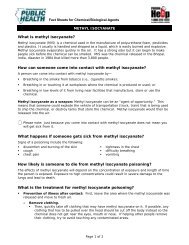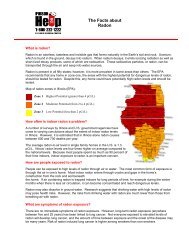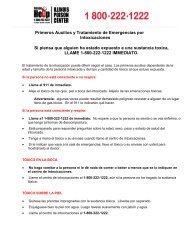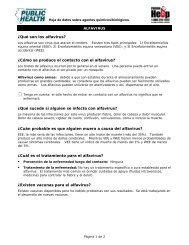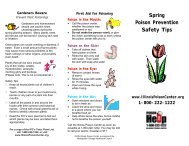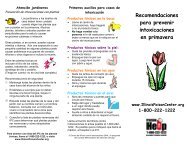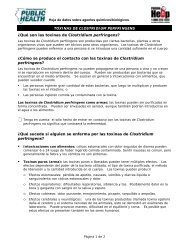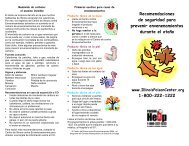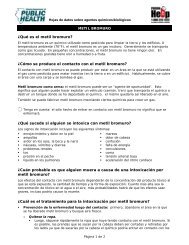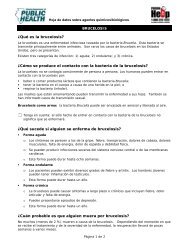Summer Brochure - Illinois Poison Center
Summer Brochure - Illinois Poison Center
Summer Brochure - Illinois Poison Center
You also want an ePaper? Increase the reach of your titles
YUMPU automatically turns print PDFs into web optimized ePapers that Google loves.
Be Safe from Bites and Stings<br />
Never underestimate the<br />
power of an irritating insect bite<br />
or sting. Most people who are<br />
stung by an insect will<br />
experience redness, itching, swelling and<br />
some pain around the sting site. In some<br />
cases, stings can be poisonous, cause<br />
allergic reactions or carry diseases. In<br />
extreme cases, they can cause death.<br />
Insect Repellent Safety<br />
Small amounts of insect<br />
repellents generally will not have<br />
harmful effects. However, DEET<br />
(N,N-diethyl-m-toluamide), one<br />
of the most effective ingredients in topical<br />
insect repellents, may be dangerous. Current<br />
studies show that it is acceptable to use<br />
concentrations of up to 30 percent for adults<br />
and children as young as two months old.<br />
The concentration of DEET is proportional<br />
to the amount of time it protects. For<br />
example, products with concentrations of 10<br />
percent are effective for about two hours;<br />
products with a concentration of 24 percent<br />
protect an average of five hours.<br />
Safety Tips<br />
• Wear clothing that will cover as much<br />
exposed skin as possible when outdoors.<br />
• Select a product with the lowest<br />
concentration of DEET effective for the<br />
amount of time you plan to spend<br />
outdoors.<br />
• Follow the directions on the label of insect<br />
repellents.<br />
• Wash your hands after using insect<br />
repellents and pesticides.<br />
First Aid for <strong>Poison</strong>ing<br />
<strong>Poison</strong> in the Mouth:<br />
• Call the poison center,<br />
whether the poison was<br />
swallowed or not.<br />
• Do not make the<br />
person vomit, or give the victim<br />
something to eat or drink unless the<br />
poison center tells you to.<br />
<strong>Poison</strong> on the Skin:<br />
• Take off clothes that<br />
have poison on them.<br />
• Rinse the skin very well<br />
with water. Then wash<br />
the skin with soap and water.<br />
<strong>Poison</strong> in the Eye:<br />
• Remove contact lenses (if<br />
worn).<br />
• Rinse the eyes with water<br />
for 15 minutes.<br />
• Open and close the eyes while rinsing.<br />
<strong>Poison</strong> in the Air:<br />
• Open windows and doors<br />
to let in fresh air.<br />
• Leave the area and move<br />
to a place where you can<br />
breathe fresh air.<br />
• Help others leave the area, but be careful<br />
not to breathe the poison yourself.<br />
Call the <strong>Illinois</strong> <strong>Poison</strong> <strong>Center</strong> as soon as<br />
possible at 1-800-222-1222. You may be told<br />
to call your doctor, hospital or 911.<br />
©2004 <strong>Illinois</strong> <strong>Poison</strong> <strong>Center</strong>, a program of the<br />
Metropolitan Chicago Healthcare Council<br />
<strong>Summer</strong><br />
<strong>Poison</strong> Prevention<br />
Safety Tips<br />
www.<strong>Illinois</strong><strong>Poison</strong><strong>Center</strong>.org<br />
1-800-222-1222
Don’t Let Food <strong>Poison</strong>ing<br />
Spoil the Day<br />
Food poisoning is<br />
a major concern as<br />
many people take<br />
advantage of the warm<br />
weather to barbecue<br />
outdoors, have a<br />
picnic in the park or go on a camping trip,<br />
Food poisoning is caused by bacteria,<br />
which grow in certain foods when they are not<br />
handled, cooked or stored properly.<br />
Symptoms:<br />
• Nausea • Vomiting • Diarrhea<br />
• Stomach cramps • Fever<br />
One or more of these symptoms usually<br />
develop within a few hours to a few days after<br />
eating the contaminated food.<br />
Following these tips will help keep your<br />
family safe from food bacteria.<br />
Preparation Tips:<br />
ä Pack hot foods in insulated containers.<br />
ä Pack refrigerated foods just before leaving<br />
home.<br />
ä Pack extra clean plates to avoid crosscontamination<br />
of raw and cooked foods.<br />
ä Place coolers in shaded areas and cover<br />
them with blankets.<br />
ä Use separate cutting boards for meats,<br />
poultry and fish.<br />
Cooking Tips:<br />
ä Wash your hands<br />
frequently while cooking.<br />
ä Wash all fruits and vegetables.<br />
ä Do not place cooked food on the same<br />
plate as raw food.<br />
ä Cook food completely.<br />
ä Cook foods as close to serving time as<br />
possible.<br />
Storage:<br />
ä Refrigerate food within two hours after<br />
cooking.<br />
ä Do not put hot food into the refrigerator or<br />
cooler.<br />
ä Most leftovers should be eaten within<br />
three to four days. Freeze the food if you<br />
don’t plan on eating it before then.<br />
Call the IPC toll-free at 1-800-222-1222 if<br />
food poisoning is suspected. Even if camping<br />
out of state, the national poison center<br />
number, 1-800-222-1222, will connect callers<br />
to a poison center for immediate help and<br />
poison prevention advice.<br />
Use <strong>Summer</strong> Products Safely<br />
Pool Products: Bromine and chlorine, two<br />
common pool chemicals, usually come in<br />
tablet or powder form and can be dangerous if<br />
the chemical’s dust is breathed in. (This<br />
happens frequently when the container is first<br />
opened.) The dust can cause skin rashes,<br />
eye irritation and shortness of breath, similar<br />
to an asthma attack.<br />
Š Store these products out of the reach of<br />
children.<br />
Š Keep away from the eyes and mouth;<br />
wash hands after touching the product.<br />
Sunscreens: Consuming a small amount<br />
usually does not cause symptoms, but<br />
ingesting larger amounts may result in<br />
nausea, vomiting and diarrhea.<br />
Ö Keep the product up high and out of the<br />
reach of children.<br />
Ö Use the product according to the<br />
directions on the label.<br />
Mushrooms Can Be Deadly<br />
Thousands of types of<br />
mushrooms exist in North<br />
America. Though relatively<br />
few are poisonous, some<br />
mushrooms can be<br />
dangerous if eaten.<br />
<strong>Poison</strong>ous mushrooms can be found across<br />
the state of <strong>Illinois</strong> – on lawns, in fields, on<br />
forest floors and on rotting wood products.<br />
Symptoms:<br />
Symptoms of mushroom<br />
poisoning vary depending on the<br />
mushroom involved. Some possible<br />
symptoms include:<br />
• Vomiting • Stomach pain • Liver failure<br />
• Bloody diarrhea • Seizures • Coma<br />
• Hallucinations • Flashbacks<br />
• Death<br />
Since mushroom identification is<br />
extremely difficult and complex, it is best left<br />
to the experts, known as mycologists. The<br />
IPC advises against picking and eating any<br />
wild mushrooms.



